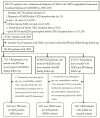Impact of Acid Suppression Therapy on Renal and Survival Outcomes in Patients with Chronic Kidney Disease: A Taiwanese Nationwide Cohort Study
- PMID: 36233478
- PMCID: PMC9570958
- DOI: 10.3390/jcm11195612
Impact of Acid Suppression Therapy on Renal and Survival Outcomes in Patients with Chronic Kidney Disease: A Taiwanese Nationwide Cohort Study
Abstract
Histamine-2-receptor antagonist (H2RA) has shown beneficial effects on the kidney, heart, and sepsis in animal models and on the heart and COVID-19 infection in clinical studies. However, H2RAshave been used as a reference in most epidemiological studies examining the association of proton pump inhibitors (PPI) with outcomes. Therefore, we aimed to evaluate the effect of H2RA on renal and survival outcomes in chronic kidney disease (CKD) patients. We used a Taiwanese nationalhealth insurance database from 2001 to 2016 to screen 45,767 CKD patients for eligibility. We identified new users of PPI (n = 7121), H2RA (n = 48,609), and users of neither PPI nor H2RA (as controls) (n = 47,072) during follow-up, and finally created 1:1:1 propensityscore-matchedcohorts; each cohort contained 4361 patients. Participants were followed up after receivingacid-suppression agents or on the corresponding date until the occurrence of end-stage renal disease (ESRD) in the presence of competing mortality, death, or through the end of 2016. Compared toneither users, H2RAand PPI users demonstrated adjusted hazard ratios of 0.40 (95% confidence interval, 0.30-0.53) for ESRDand 0.64 (0.57-0.72) for death and 1.15 (0.91-1.45) for ESRD and 1.83 (1.65-2.03) for death, respectively. A dose-response relationship betweenH2RA use with ESRD and overall, cardiovascular, and non-cardiovascular mortality was detected. H2RA consistently provided renal and survival benefits on multivariable stratified analyses and multiple sensitivity analyses. In conclusion, dose-dependent H2RA use was associated with a reduced risk of ESRD and overall mortality in CKD patients, whereas PPI use was associated with an increased risk of overall mortality, not in a dose-dependent manner.
Keywords: CKD; ESRD; dose-response relationship; histamine-2-receptor antagonist; mortality; proton pump inhibitor.
Conflict of interest statement
The authors declare no conflict of interest.
Figures
Similar articles
-
Drug-Drug Interactions, Medication Adherence, and Stroke Should Be Considered When Approaching the Impact of Acid Suppression Therapy on Chronic Kidney Disease Patients. Comment on Chen et al. Impact of Acid Suppression Therapy on Renal and Survival Outcomes in Patients with Chronic Kidney Disease: A Taiwanese Nationwide Cohort Study. J. Clin. Med. 2022, 11, 5612.J Clin Med. 2022 Dec 22;12(1):72. doi: 10.3390/jcm12010072. J Clin Med. 2022. PMID: 36614873 Free PMC article.
-
Histamine-2 Receptor Antagonists and Proton Pump Inhibitors Are Associated With Reduced Risk of SARS-CoV-2 Infection Without Comorbidities Including Diabetes, Hypertension, and Dyslipidemia: A Propensity Score-Matched Nationwide Cohort Study.J Korean Med Sci. 2023 Apr 3;38(13):e99. doi: 10.3346/jkms.2023.38.e99. J Korean Med Sci. 2023. PMID: 37012686 Free PMC article.
-
Non-indicated initiation of proton pump inhibitor and risk of adverse outcomes in patients with underlying chronic kidney disease: a nationwide, retrospective, cohort study.BMJ Open. 2024 Jan 29;14(1):e078032. doi: 10.1136/bmjopen-2023-078032. BMJ Open. 2024. PMID: 38286693 Free PMC article.
-
The use of anti-ulcer agents and the risk of chronic kidney disease: a meta-analysis.Int Urol Nephrol. 2018 Oct;50(10):1835-1843. doi: 10.1007/s11255-018-1908-8. Epub 2018 Jun 13. Int Urol Nephrol. 2018. PMID: 29948864
-
Association between Proton Pump Inhibitor Use and Risk of Incident Chronic Kidney Disease: Systematic Review and Meta-Analysis.Biomedicines. 2024 Jun 25;12(7):1414. doi: 10.3390/biomedicines12071414. Biomedicines. 2024. PMID: 39061988 Free PMC article. Review.
Cited by
-
Reply to Li, A.-H.; Chiu, Y.-L. Drug-Drug Interactions, Medication Adherence, and Stroke Should Be Considered When Approaching the Impact of Acid Suppression Therapy on Chronic Kidney Disease Patients. Comment on "Chen et al. Impact of Acid Suppression Therapy on Renal and Survival Outcomes in Patients with Chronic Kidney Disease: A Taiwanese Nationwide Cohort Study. J. Clin. Med. 2022, 11, 5612".J Clin Med. 2022 Dec 26;12(1):171. doi: 10.3390/jcm12010171. J Clin Med. 2022. PMID: 36614972 Free PMC article.
-
Disproportionality Analysis of Renal Adverse Events Associated with a Combination of Immune Checkpoint Inhibitors and Acid-Suppressing Agents-A Pharmacovigilance Study Based on the FAERS Database.J Clin Med. 2025 May 20;14(10):3581. doi: 10.3390/jcm14103581. J Clin Med. 2025. PMID: 40429576 Free PMC article.
-
Impact of Proton Pump Inhibitors on Kidney Function and Chronic Kidney Disease Progression: A Systematic Review.Cureus. 2023 Dec 3;15(12):e49883. doi: 10.7759/cureus.49883. eCollection 2023 Dec. Cureus. 2023. PMID: 38174181 Free PMC article. Review.
-
Sixteen prescribed Chinese herbal medicines provide time-dependent cardiorenal and survival benefits in patients with overall and advanced diabetic kidney disease: a real-world study in Taiwan.Front Pharmacol. 2024 Aug 22;15:1297854. doi: 10.3389/fphar.2024.1297854. eCollection 2024. Front Pharmacol. 2024. PMID: 39239654 Free PMC article.
-
Drug-Drug Interactions, Medication Adherence, and Stroke Should Be Considered When Approaching the Impact of Acid Suppression Therapy on Chronic Kidney Disease Patients. Comment on Chen et al. Impact of Acid Suppression Therapy on Renal and Survival Outcomes in Patients with Chronic Kidney Disease: A Taiwanese Nationwide Cohort Study. J. Clin. Med. 2022, 11, 5612.J Clin Med. 2022 Dec 22;12(1):72. doi: 10.3390/jcm12010072. J Clin Med. 2022. PMID: 36614873 Free PMC article.
References
-
- Forgacs I., Loganayagam A. Overprescribing proton pump inhibitors. BMJ. 2008;336:2–3. doi: 10.1136/bmj.39406.449456.BE. - DOI - PMC - PubMed
Grants and funding
LinkOut - more resources
Full Text Sources


